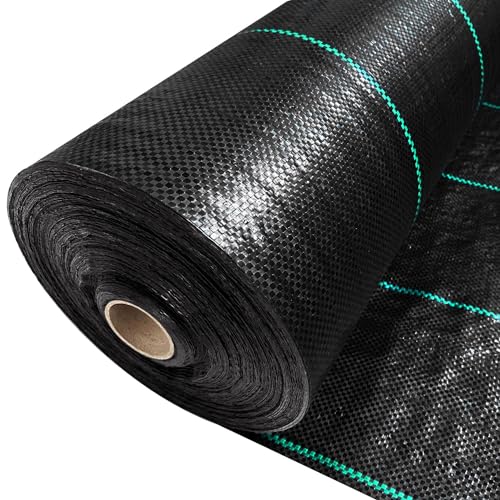If you’re looking to install a French drain on your property, you may be wondering what kind of landscape fabric to use. French drains are an effective way to manage excess water and prevent flooding, but choosing the right fabric is crucial to ensure your drain functions properly. In this article, we’ll cover everything you need to know about selecting landscape fabric for your French drain.

First, we’ll explain the basics of French drains and how they work. Then, we’ll dive into the different types of landscape fabric available and which ones are best suited for French drains. Finally, we’ll provide some tips on designing and installing your French drain, as well as maintaining it over time. By the end of this article, you’ll have all the knowledge you need to choose the right landscape fabric for your French drain and ensure it functions effectively for years to come.
Key Takeaways
- Understanding the basics of French drains is crucial to selecting the right landscape fabric.
- Woven and non-woven fabrics are both suitable for French drains, but non-woven is generally preferred.
- Proper design, installation, and maintenance are key to ensuring your French drain functions effectively.
Understanding French Drains


The Basics of French Drains
If you’re looking to keep your landscape in good shape, you’ll need to know about French drains. A French drain is a type of drainage system that uses a perforated pipe laid in a trench filled with gravel and covered with landscape fabric. The system is designed to direct water away from your foundation and yard, preventing water damage and soil erosion.
The first step in installing a French drain is to determine the slope of your yard. This will help you to determine the best location for the drain, as well as the direction in which the water should flow. Once you have determined the slope, you can start digging the trench for the drain.
Next, you will need to lay down the landscape fabric in the trench. This fabric will help to prevent soil and debris from clogging the drain over time. Be sure to choose a high-quality fabric that is designed for use with French drains.
Benefits of Proper Drainage
Proper drainage is essential for maintaining a healthy landscape. Without proper drainage, water can collect around your foundation, causing damage and erosion. French drains are an effective way to direct water away from your foundation and yard, preventing these issues from occurring.
By installing a French drain, you can also help to prevent soil erosion. When water is allowed to collect in one area, it can wash away soil and other debris, leaving your landscape vulnerable to damage. A French drain can help to prevent this by directing water away from your yard and into a designated drainage area.
Overall, a French drain is an effective way to protect your landscape from water damage and soil erosion. By understanding the basics of French drains and the benefits of proper drainage, you can create a healthy and beautiful landscape that will last for years to come.
Selecting Landscape Fabric
https://www.youtube.com/watch?v=v8cqR6nXjXs&embed=true
When it comes to selecting landscape fabric for your French drain, there are a few things to consider. In this section, we’ll discuss the types of landscape fabric, the differences between woven and non-woven geotextile, and the importance of permeability and filtration.
Types of Landscape Fabric
There are two main types of landscape fabric: woven and non-woven geotextile. Woven geotextile is made by weaving polypropylene threads together, creating a strong, durable fabric. Non-woven geotextile, on the other hand, is made by bonding fibers together using heat and pressure.
Woven vs Non-Woven Geotextile
Woven geotextile is ideal for providing support to the trench, while non-woven geotextile is better for preventing water percolation and soil erosion. According to Whizzy Living, woven linen is the best fabric to support the trench, while non-woven geotextiles ranging from 4 oz to 6 oz in weight are ideal for preventing water percolation and soil erosion. However, synthetic nylon fabrics should be avoided as they may tear and clog your drain system.
Permeability and Filtration
Permeability and filtration are two important factors to consider when selecting landscape fabric for your French drain. The fabric should be permeable enough to allow water to flow through it, but not so permeable that it allows sediment and debris to enter the drain. According to Eastgate Supply, woven fabric is ideal for use as a weed barrier, beneath roads and paths, and in parking lots, while non-woven fabric is best for use in French drains.
To summarize, when selecting landscape fabric for your French drain, consider the type of fabric, the differences between woven and non-woven geotextile, and the importance of permeability and filtration. By taking these factors into account, you can ensure that your French drain functions properly and effectively.
Designing Your French Drain

Planning and Design
Before installing a French drain, you need to plan and design it carefully. You should consider factors such as the size of your property, the type of soil, and the location of your drainage system. Make sure you measure the area where you want to install the French drain and mark the spot where you want to place the drain outlet.
Determining the Correct Slope
The correct slope is essential for the proper functioning of a French drain. You should ensure that the slope is sufficient to allow water to flow towards the drain outlet. The recommended slope for a French drain is 1% or 1/8 inch per foot. This slope will help to prevent water from pooling around the drain and causing damage to your property.
Choosing the Right Location
Choosing the right location for your French drain is critical. You need to consider the location of your property, the type of soil, and the drainage system. You should avoid installing the French drain near trees or plants with deep roots, as they can damage the drain pipes. Also, ensure that the location you choose is not too close to your neighbor’s property.
When it comes to landscape fabric for a French drain, you have several options to choose from. Woven geotextile fabric and non-woven geotextile fabric are the most commonly used fabrics for French drains. Woven geotextile fabric is more durable and can withstand heavy loads, while non-woven geotextile fabric is more flexible and easier to install.
In conclusion, planning and designing your French drain is crucial to ensure that it functions correctly. You should determine the correct slope and choose the right location for your drainage system. When it comes to landscape fabric, you should choose a fabric that is suitable for your French drain and can withstand the soil and water pressure.
Materials and Installation
https://www.youtube.com/watch?v=JhmVT9FO72I&embed=true
« Is Landscape Photography the Same as Nature? A Friendly Explanation Why Is Landscaping a Good Job: Exploring the Benefits of Working in the Landscaping Industry »
Essential Materials
Installing a French drain requires a few essential materials to ensure proper drainage. These include a trench, gravel, landscape fabric, perforated pipe, crushed stone, and sand. The trench should be dug to the desired depth and width, and the bottom should be filled with a layer of gravel. Landscape fabric should then be laid over the gravel to prevent soil and debris from entering the drain system.
Next, lay the perforated pipe on top of the fabric and surround it with more gravel. The pipe should be sloped slightly downhill and directed towards the desired exit point. Finally, cover the gravel with a layer of crushed stone and sand to prevent soil from entering the system and to promote proper drainage.
Installation Steps
Installing a French drain can be a DIY project, but it requires careful planning and attention to detail. Begin by marking the desired location of the drain and carefully digging the trench. Next, lay the landscape fabric over the bottom and sides of the trench, ensuring that it extends up the sides of the trench.
Lay the perforated pipe on top of the fabric and surround it with gravel, ensuring that the pipe is sloped towards the desired exit point. Cover the pipe with more fabric and a layer of crushed stone and sand. Finally, backfill the trench with soil and compact it to ensure proper drainage.
Common Installation Mistakes
When installing a French drain, there are several common mistakes that can be easily avoided. One of the most common mistakes is failing to slope the drain properly. The drain should be sloped at a rate of 1/8 inch per foot to ensure proper drainage.
Another common mistake is failing to use enough gravel. The gravel should be at least 2 to 3 inches deep to provide adequate drainage. Additionally, failing to use landscape fabric can result in soil and debris entering the drain system and clogging the pipes.
Finally, it is important to use the proper tools when installing a French drain. This includes a shovel, wheelbarrow, and level to ensure that the trench is level and the drain is sloped properly. With careful planning and attention to detail, you can install a French drain that will provide years of reliable drainage.
Maintenance and Troubleshooting

Keeping Your Drain Functional
To ensure that your French drain remains functional, it is important to perform regular maintenance. This includes inspecting the drain for any signs of clogging, sediment buildup, or other drainage problems. If you notice any issues, it is important to address them as soon as possible to prevent water pooling or erosion.
One way to maintain your French drain is to regularly clean the catch basin. This will prevent any debris or silt from entering the drainage system and causing clogs. You can also install a sediment filter to help trap any sediment that may enter the drain.
Another important maintenance step is to check the drainage system for any signs of erosion. If you notice any erosion, it is important to address the issue as soon as possible to prevent further damage. You can use landscaping materials such as rocks or gravel to help stabilize the soil and prevent erosion.
Addressing Common Issues
If you notice any issues with your French drain, such as water pooling or sediment buildup, there are a few troubleshooting steps you can take. One common issue is a clogged drain, which can be caused by debris or sediment buildup. To address this issue, you can try flushing the drain with water or using a drain snake to remove any blockages.
Another common issue is water pooling around the drain. This can be caused by a variety of factors, including a poorly designed drainage system or a clogged catch basin. To address this issue, you may need to install additional drainage pipes or adjust the slope of the drain to ensure proper water flow.
Overall, regular maintenance and troubleshooting can help ensure that your French drain remains functional and efficient. By taking these steps, you can prevent drainage problems, erosion, and other issues that can cause damage to your property.
Legal and Environmental Considerations

When planning to install a French drain, it is important to consider the legal and environmental implications of your project. Failure to comply with zoning laws, building codes, and community rules can result in hefty fines, legal action, or even the removal of your drainage system. Additionally, improper installation of a French drain can have a negative impact on your neighbors and the environment.
Understanding Zoning Laws
Before installing a French drain, it is important to research your local zoning laws. Zoning laws dictate what types of structures and modifications can be made to your property. Failure to comply with these laws can result in legal action and fines. Additionally, some areas may have specific regulations regarding the installation of drainage systems. It is important to consult with your local zoning board to ensure that your project is in compliance with all applicable laws.
Impact on Neighbors and Environment
Improper installation of a French drain can have a negative impact on your neighbors and the environment. For example, if your drainage system is not properly designed, it could cause erosion and damage to neighboring properties. Additionally, if your French drain is not installed with erosion control measures, it could contribute to soil erosion and damage to the environment.
It is important to consider the impact of your French drain on the environment and your neighbors. Consult with a professional landscaper or drainage contractor to ensure that your project is properly designed and installed with erosion control measures. By taking these steps, you can ensure that your French drain is a positive addition to your property and does not cause harm to the environment or your neighbors.
Frequently Asked Questions

What is the ideal material to use as a lining for a French drain?
The ideal material to use as a lining for a French drain is a geotextile fabric. This fabric is designed to allow water to pass through while keeping soil and other debris from clogging the drain.
How does landscape fabric differ from drainage fabric in terms of usage?
Landscape fabric is not designed for drainage purposes. It is typically used to suppress weeds and control erosion. Drainage fabric, on the other hand, is specifically designed to allow water to pass through and is ideal for French drain systems.
Which type of landscape fabric is most effective for drainage purposes?
Non-woven geotextile fabric is the most effective type of landscape fabric for drainage purposes. This type of fabric is made of synthetic fibers that are bonded together to create a durable, water-permeable material.
Can non-woven geotextile fabric be used for French drains, and if so, how?
Yes, non-woven geotextile fabric can be used for French drains. It should be installed between the soil and the gravel to prevent soil particles from clogging the drain. The fabric should be wrapped around the gravel and secured in place with stakes.
What specifications should I look for when choosing fabric for a French drain at home improvement stores?
When choosing fabric for a French drain at home improvement stores, look for a non-woven geotextile fabric with a weight of at least 4 ounces per square yard. The fabric should also be UV-resistant and have a high water flow rate.
Is there a particular type of gravel that works best with French drain systems?
Yes, angular gravel with a diameter between ½ inch and 1 inch works best with French drain systems. This type of gravel allows water to flow freely while providing enough space for the fabric to wrap around it. Avoid using rounded gravel, as it can shift and settle over time, causing the drain to clog.
















